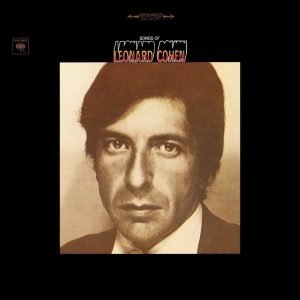When Songs of Leonard Cohen arrived in 1967, it introduced a new kind of voice to the folk music scene—quiet, poetic, and deeply reflective. Leonard Cohen was already known in Canada as a poet and novelist, but this debut album marked his entry into the world of music. At a time when folk and rock music were often loud with protest or rich with lush arrangements, Cohen went the other way. His songs were stripped down, focused more on words than volume, and they held a quiet strength that stood apart.
Placed alongside the work of artists like Bob Dylan or Joni Mitchell, Cohen’s debut feels more inward, even mystical. There’s no clear shift from earlier musical work because there was none. This was his first, and it landed like a whisper in a room full of shouting—small in scale but impossible to ignore.
Cohen’s goal for the album was simple but bold. He wanted to keep the music minimal so that the lyrics could lead. Though producers pushed for more complex arrangements, Cohen insisted on a softer touch. His songs, built mostly on guitar and voice, feel like confessions set to melody. Each track opens a window into longing, love, and spiritual search. He didn’t write to impress—he wrote to reveal.
Sonic Exploration

The sound of Songs of Leonard Cohen is as sparse and deliberate as the words it holds. The production, handled by John Simon, leans toward the minimal. It avoids the polish and gloss common in many late-1960s releases. Instead, it offers something more intimate and bare. Cohen’s voice, deep and unhurried, sits front and center. Around it, the instruments are kept at a distance, almost ghostly, which fits the album’s themes of longing and emotional distance.
While the overall production isn’t lo-fi in a technical sense, it does favor rawness over clarity. The mix allows silence to speak just as much as sound. The quiet spaces between notes feel intentional. They draw the listener closer, creating a sense of closeness—as if Cohen is sitting beside you, whispering his verses in the dark.
The arrangements are modest but artful. Acoustic guitar leads the way, forming the backbone of most tracks. Gentle touches of strings and backing vocals rise at key moments, adding depth without overwhelming. Female backing singers, like those in “Suzanne” and “So Long, Marianne,” bring a haunting contrast to Cohen’s dry, weathered tone. These moments don’t just lift the songs—they widen the emotional lens through which we hear them.
Genre-wise, the album lives within the folk tradition but it bends the genre’s usual expectations. There are traces of European chanson and the literary feel of art song. It avoids the American folk revival’s earthy roughness, instead offering something quieter, more urbane. This gives Songs of Leonard Cohen a genre-blending quality that was ahead of its time—rooted in folk, but filtered through poetry and the lens of a novelist.
Lyrical Analysis

The heart of Songs of Leonard Cohen lies in its lyrics. From the first track to the last, Cohen explores themes of love, loss, faith, and identity with a poet’s touch. These aren’t love songs in the usual sense. They are stories of love’s aftermath, of longing that never quite finds resolution, and of the quiet ache that lingers in the absence.
Recurring images of women, cities, rivers, and spiritual symbols run through the album. In “Suzanne,” Cohen blends the sacred and the sensual, creating a portrait of a woman who offers both physical and spiritual connection. The lyrics drift between the real and the mystical, showing how closely Cohen ties emotional experiences to religious or mythic language. In “Sisters of Mercy,” the tone shifts toward gratitude and solace, casting fleeting human connections as moments of quiet salvation.
Cohen’s writing walks a line between the clear and the cryptic. Some songs feel like short stories—narrative, but layered with metaphor. Others are more abstract, leaving room for interpretation. What stays consistent is the sense of precision. Cohen never wastes a word. His lines often carry double meanings, inviting listeners to read deeper, to listen again.
The emotional effect of these lyrics is striking. There’s a softness in Cohen’s delivery that amplifies the vulnerability in his words. He doesn’t demand sympathy—he invites reflection. His songs don’t offer easy answers, but they do offer understanding. Sadness is here, yes, but so is beauty. So is grace. And that emotional depth is what gives this album its lasting power. Each line is a small revelation, each song a quiet unfolding of the soul.
Cohesion and Flow

Songs of Leonard Cohen unfolds with a quiet, deliberate grace. From the opening notes of “Suzanne” to the final chords of “One of Us Cannot Be Wrong,” the album feels like a continuous emotional journey rather than a collection of separate tracks. Each song follows the last with a natural rhythm, not through strict narrative but through tone and texture. The pacing is slow, almost meditative, which helps to sustain the listener’s immersion in Cohen’s world.
While there isn’t a clear storyline running through the album, the emotional arc is unmistakable. It begins with a gentle invitation, moves through moments of desire, loss, reflection, and finally ends in a place of hushed resignation. Songs like “Master Song” and “Stranger Song” add tension, while “So Long, Marianne” and “Hey, That’s No Way to Say Goodbye” offer warmth and melancholy in equal measure. The shifts are subtle, never jarring, and they contribute to a sense of slow-burning revelation.
Thematic consistency is one of the album’s greatest strengths. Cohen’s subjects—love, solitude, spiritual seeking—appear again and again, dressed in different images but always carrying the same emotional weight. The arrangements stay within a narrow sonic palette, which helps unify the record. Even as the emotional tones change, the overall feeling remains steady. It’s a quiet world he builds here, and every track belongs to it.
Standout Tracks and Moments
While Songs of Leonard Cohen holds a quiet consistency throughout, several tracks rise to the surface as emotional and artistic high points. These songs not only anchor the album, but they also showcase Cohen’s skill as a songwriter and storyteller.
Suzanne
“Suzanne” is perhaps the most iconic track, and for good reason. It opens the album with a haunting melody and lyrics that blur the line between romantic and spiritual love. The imagery is vivid—tea and oranges by the river, Jesus walking on water—yet the emotional pull is gentle, almost hypnotic. Cohen’s voice, steady and soft, draws the listener in with a kind of quiet gravity.
So Long, Marianne
“So Long, Marianne” stands out for its emotional openness. It’s one of the more musically uplifting moments on the album, yet the lyrics tell a bittersweet story of parting. The contrast between its bright melody and its mournful tone creates a complex emotional space—one that feels both nostalgic and resigned. The repeated chorus feels like a farewell you never really want to say.
Stranger Song
In “Stranger Song,” Cohen uses repetition and lyrical layering to great effect. The phrase “you’ve used up all your coupons” becomes a refrain that takes on new meaning with each return. This song, more than many others, reveals Cohen’s ability to build a song like a poem—each line folding into the next with growing emotional weight.
Memorable Moments
A subtle but unforgettable moment comes in “Sisters of Mercy,” where the female backing vocals swell behind Cohen’s lead. It’s not loud or dramatic, but it shifts the emotional tone in a way that feels sacred. It gives the impression of being held, even in the midst of loneliness.
Even the final track, “One of Us Cannot Be Wrong,” leaves a lasting impression with its closing moments. The strange, high-pitched wailing in the background is jarring at first, yet it becomes a strange echo of the emotional pain described in the lyrics. It’s a moment where Cohen lets the song come slightly undone, ending the album not with resolution but with emotional release.
Artistic Contribution and Innovation

Songs of Leonard Cohen may not have stormed the charts upon release, but its impact on the singer-songwriter tradition is undeniable. In a late-1960s landscape filled with psychedelic rock and politicized folk, Cohen offered something quieter, more inward-facing. His debut didn’t push boundaries in volume or experimentation, but it broke ground in its restraint. He brought the language of poetry into the folk idiom with a precision that few had achieved before him.
Within the folk genre, Cohen carved out a space that was both literary and spiritual. While artists like Bob Dylan leaned toward satire and surrealism, Cohen’s style was more meditative. He treated songs as vessels for reflection rather than protest. This approach influenced a generation of artists who followed—Nick Drake, Joni Mitchell, and later, acts like Iron & Wine or Sufjan Stevens, who also embraced minimalism and introspective lyricism.
Innovation
What feels most innovative about this album is its emotional economy. Cohen could distill complex feelings into a few simple phrases, making the personal feel universal. His use of female backing vocals added a new texture to folk music, softening the starkness of his voice and creating a subtle interplay between masculine and feminine energy. It’s not flashy innovation, but it’s enduring.
Thematically, Cohen’s blend of the sacred and the profane also set him apart. Few albums of the time so seamlessly wove together images of romantic longing and spiritual yearning. He didn’t shy away from ambiguity. Instead, he made it a strength, trusting the listener to sit with uncertainty and find meaning in the spaces between words.
In that sense, Songs of Leonard Cohen didn’t just add to the folk canon—it expanded it. It showed that a song could be a prayer, a confession, or a poem, all at once. That artistic vision, quiet and deliberate, continues to echo in the work of countless artists across genres.
Closing Thoughts

Songs of Leonard Cohen is a rare kind of debut—fully formed, thematically rich, and emotionally fearless. Its strengths lie not in grand gestures but in its quiet confidence. Cohen’s voice, though technically unrefined, carries a weight of experience and thought that few artists ever achieve. His lyrics are precise yet open-ended, drawing listeners into a space of reflection and vulnerability. Musically, the album remains subtle, never overstating its presence, which allows its emotional content to come through unfiltered.
If the album has any weakness, it might be its uniform pacing and minimal arrangements, which some listeners might find too subdued. But for those willing to engage deeply, this restraint becomes a virtue. It encourages active listening and rewards repeated visits. The songs don’t chase attention—they earn it slowly, through honesty and clarity.
As a starting point in Cohen’s recording career, Songs of Leonard Cohen sets a tone he would return to and evolve throughout his life. It introduced his voice—not just as a singer, but as a thinker, a seeker, and a chronicler of the human heart. For listeners today, it still offers solace and insight, especially in quiet moments when reflection feels necessary.
Rating: 10/10
This album earns a perfect score not because it tries to be perfect, but because it stays true to itself. It knows its voice, honors its themes, and delivers an emotional experience that feels both intimate and enduring. Few debut albums have shaped the musical and literary landscape so quietly and so completely. Songs of Leonard Cohen is not just a strong introduction—it’s a foundational text in modern songwriting.
